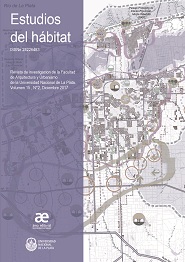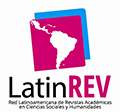Hygrothermal and energy performance in summer period of a typical school building in the city of San Juan, Argentina
DOI:
https://doi.org/10.24215/24226483e028Keywords:
School building, Energy evaluation, Hygrothermal comfortAbstract
The objective of this work is to evaluate summer hygrothermal and energy performance of a representative school building in the city of San Juan, Argentina. To achieve it, solar irradiance, temperature and humidity measurements, made every 15 minutes during periods of 15 to 20 consecutive days in three key moments in the years 2013-2014 under different conditions of use, are processed with PROMEDI-HTL. These records are related to daily readings of electricity consumption. Additionally, comfort levels are studied in three classrooms using Fanger method to determine the PMV index (Predicted value Middle) and PPD (Percentage of Persons in Discomfort) with specific software. Monthly series of nine years of power consumption are analyzed statistically and stationary thermal-energy calculation is made applying the IRAM regulations through KG-MOD model. Empirical values are compared with the theoretical obtained.
Downloads
Metrics
References
Blasco Lucas, Irene (2013). Arquitectura sustentable en hábitat rural de zona árido-sísmica: Aportes teórico-metodológicos. Tesis Doctoral en Arquitectura. Universidad de Mendoza.
Boutet, M.L.; Hernández, A.L.; Jacobo, G.J.; Martina P.E; Corace, J.J. (2011). Auditorías higrotérmicas y lumínicas de dos edificios escolares de nivel inicial de la ciudad de resistencia, en condiciones reales de ocupación. AVERMA, 15, p. 05.29 a 05.36.
Dascalaki, Elena; Sermpetzoglou, Vasileios (2011) Energy performance and indoor environmental quality in Hellenic schools. Energy and Buildings 43, p. 718 a 727. Elsevier.
Desideri, U.; Proietti, S. (2002) Analysis of energy consumption in the high schools of a province in central Italy. Energy and Buildings 34, p. 1003 a 1016. Elsevier.
Esteves, A.; Gelardi, D.; Oliva, A. (1997). The shape in the bioclimatic architecture: the FAEP factor. Proceedings of II Conference on Teachers in Architecture, Chapter 3.12.
Fanger, P.O. (1982) Thermal comfort. R.E.Krieger Publishing Company, Malabar,FI.
Filippín, Celina (2005). Uso eficiente de la energía en edificios. Ed. Amerindia. Santa Rosa, La Pampa.
Gonzalo, Guillermo E. (2003) Manual de Arquitectura Bioclimática. Editorial Nobuko. Programa para el cálculo de situación de confort: PMV y PPD. CEEMA, IAA, FAU, UNT. Noviembre 2002
Gonzalo, Guillermo E.; Nota, Viviana M. (1999) Determinación de índices de consumos de energía para distintas funciones edilicias en el área de san miguel de Tucumán. AVERMA. Vol.3, Art. 08-45
IRAM (1996, 2001, 2002, 2004, 2007 y 2012). Serie 11600 de Normas para acondicionamiento térmico de edificios. Instituto Argentino de Normalización.
ISO 7730 (2005) Ergonomics of the thermal environment. Analytical determination and interpretation of thermal comfort using calculation of the PMV and PPD indices and local thermal comfort criteria. Third edition. Switzerland.
Pepler, R.D., Warner, R.E. (1968). Temperature and learning: an experimental study. ASHRAE Transactions, 74, p. 211-219
Pontoriero, Domingo; Hoesé, Liliana (2013-2014). Programa de relevamiento de datos meteorológicos de la ciudad de San Juan. Instituto de Energía Eléctrica, UNSJ.
Ré, M. Guillermina y Blasco Lucas, Irene (2010). Comportamiento higrotérmico, lumínico y energético de edificios residenciales ubicados en la ciudad de San Juan. Revista AVERMA, 4, Art 05-35.
San Juan G.; Hoses S.; González D. (2000) Sensibilidad de variables edilicias y energéticas de tipologías edilicias escolares en dos situaciones regionales de nuestro país. AVERMA. 4. Art 07-29
Santamouris M. and Asimakopoulos D, Editores (1996) Passive Cooling of Buildings. James & James.
USGBC (2013). LEED Reference Guide V4. United States Green Building Council, Washington D. C. Disponible en: http://www.usgbc.org/leed/rating-systems/om
Downloads
Published
How to Cite
Issue
Section
License
Acorde a estos términos, el material se puede compartir (copiar y redistribuir en cualquier medio o formato) y adaptar (remezclar, transformar y crear a partir del material otra obra), siempre que a) se cite la autoría y la fuente original de su publicación (revista y URL de la obra), b) no se use para fines comerciales y c) se mantengan los mismos términos de la licencia.








.jpg)

















